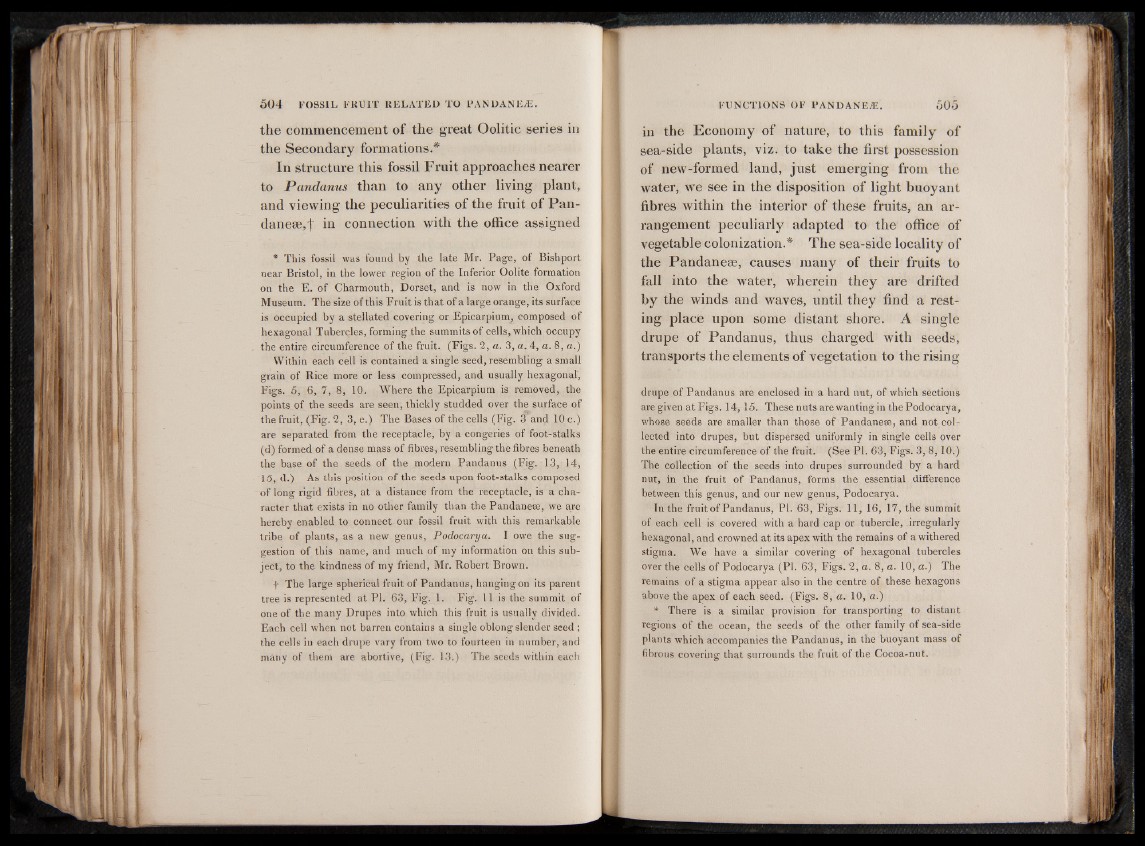
the commencement of the great Oolitic series in
the Secondary formations.*
In structure this fossil Fruit approaches nearer
to Pandanus than to any other living plant,
and viewing the peculiarities of the fruit of Pan-
daneæ,| in connection with the office assigned
* This fossil was found by the late Mr. Page, of Bishport
near Bristol, in the lower region of the Inferior Oolite formation
on the E. of Charmouth, Dorset, and is now in the Oxford
Museum. The size of this Fruit is that of a large orange, its surface
is occupied by a stellated covering or Epicarpium, composed of
hexagonal Tubercles, forming the summits of cells, which occupy
the entire circumference of the fruit. (Figs. 2, a. 3, a. 4, a. 8, a.)
Within each cell is contained a single seed, resembling a small
grain of Rice more or less compressed, and usually hexagonal,
Figs. 5, 6, 7, 8, 10. Where the Epicarpium is removed, the
points of the seeds are seen, thickly studded over the surface of
the fruit, (Fig. 2, 3, e.) The Bases of the cells (Fig. 3*and 10 c.)
are separated from the receptacle, by a congeries of foot-stalks
(d) formed of a dense mass of fibres, resembling the fibres beneath
the base of the seeds of the modern Pandanus (Fig. 13, 14,
15, d.) As this position of the seeds upon foot-stalks composed
of long rigid fibres, at a distance from the receptacle, is a character
that exists in no other family than the Pandaneee, we are
hereby enabled to connect our fossil fruit with this remarkable
tribe of plants, as a new genus, Podocarya. I owe the suggestion
of this name, and much of my information on this subject,
to the kindness of my friend, Mr. Robert Brown.
t The large spherical fruit of Pandanus, hanging on its parent
tree is represented at PI. 63, Fig. 1. Fig. 11 is the summit of
one of the many Drupes into which this fruit is usually divided.
Each cell when not barren contains a single oblong slender seed ;
the cells in each drupe vary from two to fourteen in number, and
many of them are abortive, (Fig. 13.) The seeds within each
in the Economy of nature, to this family of
sea-side plants, viz. to take the first possession
of new-formed land, just emerging from the
water, we see in the disposition of light buoyant
fibres within the interior of these fruits, an arrangement
peculiarly adapted to the office of
vegetable colonization.* The sea-side locality of
the Pandaneae, causes many of their fruits to
fall into the water, wherein they are drifted
by the winds and waves, until they find a resting
place upon some distant shore. A single
drupe of Pandanus, thus charged with seeds,
transports the elements of vegetation to the rising
drupe of Pandanus are enclosed in a hard nut, of which sections
are given at Figs. 14,15. Thesenutsarewantingin the Podocarya,
whose seeds are smaller than those of Pandaneee, and not collected
into drupes, but dispersed uniformly in single cells over
the entire circumference of the fruit. (See PI. 63, Figs. 3, 8,10.)
The collection of the seeds into drupes surrounded by a hard
nut, in the fruit of Pandanus, forms the essential difference
between this genus, and our new genus, Podocarya.
In the fruit of Pandanus, PI. 63, Figs. 11, 16, 17, the summit
of each cell is covered with a hard cap or tubercle, irregularly
hexagonal, and crowned at its apex with the remains of a withered
stigma. We have a similar covering of hexagonal tubercles
over the cells of Podocarya (PI. 63, Figs. 2, a. 8, a. 10, a.) The
remains of a stigma appear also in the centre of these hexagons
above the apex of each seed. (Figs. 8, a. 10, a.)
* There is a similar provision for transporting to distant
regions of the ocean, the seeds of the other family of sea-side
plants which accompanies the Pandanus, in the buoyant mass of
fibrous covering that surrounds the fruit of the Cocoa-nut.